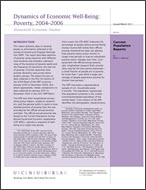Dynamics of Economic Well-Being: Poverty, 2004–2006
Dynamics of Economic Well-Being: Poverty, 2004–2006
Introduction
This report presents data on poverty based on information collected in the Survey of Income and Program Participation (SIPP). The report describes patterns of poverty using measures with different time horizons and provides a dynamic view of the duration of poverty spells and the frequency of transitions into and out of poverty. It further examines how poverty dynamics vary across demographic groups. The report focuses on data collected in the first 36 months of the 2004 Panel of the SIPP (covering January 2004 to December 2006), and where appropriate, makes comparisons to data collected for January 2001 to December 2003 in the 2001 SIPP Panel.1
The SIPP and other longitudinal surveys allow policy makers, academic researchers, and the general public to paint a more detailed portrait of poverty than the one provided by the official annual poverty estimate. The official annual poverty rate, based on the Current Population Survey Annual Social and Economic Supplement (CPS ASEC), captures a snapshot of well-being at a single time period.
Once a year, the CPS ASEC measures the percentage of people whose annual family money income falls below their official poverty threshold but does not address how poverty varies across shorter or longer time periods or how an individual’s poverty status changes over time. Compared with the official annual poverty rate, longitudinal research finds poverty rates vary by the time period examined—a small fraction of people are in poverty for more than 1 year while a larger percentage of people experience poverty for shorter time periods.2
The SIPP interviews a representative sample of U.S. households every 4 months. The population represented (the population universe) is the civilian noninstitutionalized population of the United States. Core content of the SIPP identifies the demographic characteristics, labor force participation, government program participation, and various income sources for members of sampled households.
Poverty statistics presented in this report adhere to the standards specified by Office of Management and Budget’s Statistical Policy Directive 14. The U.S. Census Bureau uses a set of money income thresholds that vary by family size and composition to determine who is in poverty. If a family’s total income is less than that family’s threshold, then that family and every individual in it are considered to be in poverty. The poverty thresholds do not vary geographically. They are updated to allow for changes in the cost of living using the Consumer Price Index (CPI-U).
Since SIPP respondents are interviewed throughout the year and asked about their income for the previous 4 months individually, each month’s income is compared to the appropriate monthly poverty threshold. Monthly thresholds are calculated by multiplying the base-year annual poverty thresholds by an inflation factor relevant to the reference month and then dividing the calculated annual threshold by 12.
This report discusses poverty rate estimates for different time periods, measures the length of time people remain poor, and follows the movement of people into and out of poverty. The poverty measures discussed include monthly, episodic, annual, and chronic poverty rates. To capture changes in poverty status over time, the report examines poverty entry rates, poverty exit rates, and the duration of poverty spells. See the text box for a more detailed description of each measure used in this report.
_______________
1 The 2004 Panel of the SIPP consisted of 48 interview months (in 12 waves) and was collected from February 2004 to January 2008. The data in this report include 36 months from the first 10 waves of the 2004 Panel collected from February 2004 to May 2007. These data are compared to 36 months of data from the 2001 Panel collected from February 2001 to January 2004 in 9 waves. The first 10 waves of the 2004 Panel, reference months January 2004 to December 2006, were used instead of January 2005 to December 2007 to include as much information prior to a 53 percent sample cut in the ninth wave. Tables A-17 and A-18 show selected 3-year estimates (2004 to 2006) and 4-year estimates (2004 to 2007).
2 Examples of previous longitudinal studies on poverty include: Stephanie R. Cellini, Signe-Mary McKernan, and Caroline Ratcliffe, “The Dynamics of Poverty in the United States: A Review of Data, Methods, and Findings,” Journal of Policy Analysis and Management 27 (2008), pp. 577–605. John Iceland, “Dynamics of Economic Well-being: Poverty 1996–1999,” Current Population Reports, Series P70-91, U.S. Census Bureau, Washington, DC, 2003. Mary Naifeh, “Dynamics of Economic Well-Being, Poverty, 1993–94: Trap Door? Revolving Door? Or Both?,” Current Population Reports, Series P70-63, U.S. Census Bureau, Washington, DC, 1998. Signe-Mary McKernan and Caroline Ratcliffe, “Transition Events in the Dynamics of Poverty, Urban Institute Research Report,” 2002, <www.urban.org/url .cfm?ID=410575>. Mary Jo Bane and David Ellwood, “Slipping Into and Out of Poverty: The Dynamics of Spells,” Journal of Human Resources 21 (1986), pp. 1–23. Ann Huff Stevens, “The Dynamics of Poverty Spells: Updating Bane and Ellwood,” AEA Papers and Proceedings 84 (1994), pp. 34–37. Ann Huff Stevens, “Climbing Out of Poverty, Falling Back In: Measuring the Persistence of Poverty Over Multiple Spells,” Journal of Human Resources 34 (1999), pp. 557–588.
Tables
Others in Series
Publication
Publication
Income and Poverty








